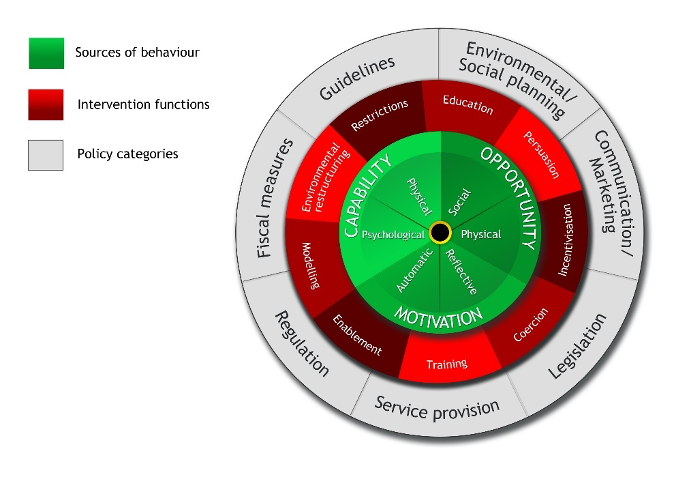Editor’s note: Matthew Hellon is a research executive at global insights agency Northstar Research, London.
In Part 1 of this series exploring behavioral science frameworks and randomized control trials we covered:
- How frameworks are an underutilized aspect of behavioral science.
- MINDSPACE and EAST frameworks.
This article will look at a third framework for creating effective behavior change interventions, the behavior change wheel (BCW). It’s an evidence-based solution for any problem that requires behavior change.
What is the BCW?
 The BCW is a step-by-step guide to developing behavior change interventions. It consists of eight steps from defining the problem in behavioral terms to choosing the intervention’s mode of delivery. It was created in 2011 by Susan Michie (currently on the U.K.’s COVID-19 Behavioral Science Advisory Group), Maartje M van Stralen and Robert West. Their paper was first published in the implementation science journal of BioMedCentral, reflecting their background as health psychologists.
The BCW is a step-by-step guide to developing behavior change interventions. It consists of eight steps from defining the problem in behavioral terms to choosing the intervention’s mode of delivery. It was created in 2011 by Susan Michie (currently on the U.K.’s COVID-19 Behavioral Science Advisory Group), Maartje M van Stralen and Robert West. Their paper was first published in the implementation science journal of BioMedCentral, reflecting their background as health psychologists.
Steps 1-3
The first step in the BCW is defining the problem in behavioral terms. This means identifying which behaviors need to change in order to overcome the problem (e.g., if the problem is childhood obesity, what behaviors contribute to this?). Steps 2 and 3 then aim to narrow in on the exact behavior that needs changing. This means selecting and specifying the target behavior (where, what, when, how, in what context, etc.). The larger the impact the behavior has on the target problem, the better. The more specific the definition of the behavior, the better. It is easier to narrow in on the barriers and facilitators to “going to the gym in the mornings three times a week” than to “getting fit.”
These steps should form part of “interrogating the brief” in any general research process. Market research is all about behavior and as such many problems can be boiled down to a very specific behavior that needs to change.
Step 4
Step 4 involves using the COM-B model (at the center of the BCW) to identify barriers and facilitators to the specified behavior. COM-B stands for three broad concepts that influence behavior:
- Capability (both physical and mental).
- Opportunity (both physical and social).
- Motivation (both automatic and reflective).
The key to this step is understanding which aspects of COM-B are preventing someone from carrying out the specified behavior. Taking our previous example, are people not attending the gym in the mornings three times a week because they don’t have a gym close enough to them (physical opportunity), lack the belief that they can use the gym effectively (mental capability) or because they don’t believe the benefits outweigh the costs (reflective motivation)?
This step can involve desk research, literature reviews, observation, qualitative interviews or other methods of research depending on the behavior and what research is already available. COM-B provides the structure necessary to move on to the next steps.

Source: https://implementationscience.biomedcentral.com/articles/10.1186/1748-5908-6-42
Steps 5-6
Once the barriers/facilitators of the specified behavior have been identified, there are established links between them and the intervention functions most likely to change behavior. For example, if someone lacks the physical opportunity to go to the gym (i.e., there are no gyms near them) then it makes most sense to use an intervention that changes the physical environment (i.e., build a closer gym or improve transport links).
There are often multiple intervention functions that can overcome each of the barriers to behavior in COM-B. For example, lacking reflective motivation (benefits don’t appear to outweigh costs) can be overcome by incentivization, persuasion, education, coercion or all four.
Steps 7-8
Intervention functions have numerous modes of delivery. For example, education comes in many forms from mass media campaigns to individual lessons. This is where the seventh and eight steps define the content of the intervention and its mode of delivery. Local/client knowledge is particularly effective here to ensure that the mode of delivery resonates with the intended audience.
Why use the BCW?
- It’s easy to follow with a step-by-step guide.
- Works for any behavior (and nearly any brief).
- COM-B provides structure to barriers/facilitators and removes “hunches.”
- The established links from COM-B barriers to intervention development increases the chances of intervention success.
The BCW is a powerful framework that takes the guesswork out of developing behavior change interventions. It makes an evidence-based practice easy to follow, leading to more effective behavior change.
We’ve now covered three important and useful behavioral science frameworks. The next and final article will look at how to accurately measure an intervention’s impact with randomized control trials –the gold standard research methodology.
